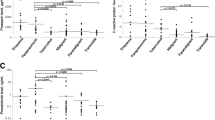Abstract
This study was to determine the diagnostic value of procalcitonin (PCT) in the differentiation of infectious and non-infectious causes of pleural effusion. From January 2005 to April 2005, we measured the PCT levels of pleural effusion from 76 patients using an immunoluminometric assay. The types of pleural infusions studied were para-pneumonic effusion (n = 26), empyema (n = 7), tuberculous pleurisy (n = 8), malignant pleural effusion (n = 25) and transudative pleural effusion (n = 8). The PCT levels were low in transudative pleural effusions (0.188 ± 0.077 ng/mL) and tuberculous pleurisy (0.130 ± 0.069 ng/mL), but high in empyema (5.147 ± 3.056 ng/mL), para-pneumonic effusion (1.091 ± 0.355 ng/mL), and malignant pleural effusion (0.241 ± 0.071 ng/mL). The receiver-operating characteristic curve analysis for an optimal discrimination between empyema and para-pneumonic effusion from non-para-pneumonic effusion could be performed at a cut-off point of 0.18 ng/mL with area under the curve of 0.776 (sensitivity: 69.7%, specificity: 72.1%). The correlation was found between pleural effusion PCT and serum PCT levels in 16 patients (r 2 = 0.967, p < 0.001). In conclusion, a high pleural effusion PCT level suggests the presence of empyema and para-pneumonic effusion.



Similar content being viewed by others
References
Assicot M, Gendrel D, Carsin H, Raymond J, Guilbaud J, Bohuon C (1993) High serum procalcitonin concentrations in patients with sepsis and infection. Lancet 341:515–518
Ugarte H, Silva E, Mercan D, De Mendonca A, Vincent JL (1999) Procalcitonin used as a marker of infection in the intensive care unit. Crit Care Med 27:498–504
Meisner M, Tschaikowsky K, Palmaers T, Schmidt J (1999) Comparison of procalcitonin (PCT) and C-reactive protein (CRP) plasma concentrations at different SOFA scores during the course of sepsis and MODS. Crit Care 3:45–55
Luyt CE, Guerin V, Combes A et al (2005) Procalcitonin kinetics as a prognostic marker of ventilator-associated pneumonia. Am J Respir Crit Care Med 171:48–53
Brunkhorst FM, Eberhard OK, Brunkhorst R (1999) Discrimination of infectious and noninfectious causes of early acute respiratory distress syndrome by procalcitonin. Crit Care Med 27:2172–2176
Christ-Crain M, Jaccard-Stolz D, Bingisser R, Gencay MM, Huber PR, Tamm M et al (2004) Effect of procalcitonin-guided treatment on antibiotic use and outcome in lower respiratory tract infections: cluster-randomized, single-blinded intervention trial. Lancet 363:600–607
Light RW, Macgregor MI, Luchsinger PC, Ball WC Jr (1972) Pleural effusion: the diagnostic separation of transudates and exudates. Ann Intern Med 77:507–513
Porcel JM, Vives M, Cao G, Bielsa S, Ruiz-González A, Martínez-Iribarren A et al (2009) Biomarkers of infection for the differential diagnosis of pleural effusions. Eur Respir J 34:1383–1389
Lin MC, Chen YC, Wu JT, Ko YC, Wang CC (2009) Diagnostic and prognostic values of pleural fluid procalcitonin in parapneumonic pleural effusions. Chest 136:205–211
Baylan O, Balkan A, Inal A, Kisa O, Albay A, Doganci L et al (2006) The predictive value of serum procalcitonin levels in adult patients with active pulmonary tuberculosis. Jpn J Infect Dis 59:164–167
Nyamande K, Lalloo UG (2006) Serum procalcitonin distinguishes CAP due to bacteria, Mycobacterium tuberculosis and PJP. Int J Tuberc Lung Dis 10:510–515
Schleicher GK, Herbert V, Brink A, Martin S, Maraj R, Galpin JS et al (2005) Procalcitonin and C-reactive protein levels in HIV-positive subjects with tuberculosis and pneumonia. Eur Respir J 25:688–692
Cakir E, Deniz O, Ozcan O, Tozkoparan E, Yaman H, Akgul EO et al (2005) Pleural fluid and serum procalcitonin as diagnostic tools in tuberculous pleurisy. Clin Biochem 38:234–238
Ho CC, Liao WY, Wang CY, Lu YH, Huang HY, Chen HY et al (2008) TREM-1 expression in tumor-associated macrophages and clinical outcome in lung cancer. Am J Respir Crit Care Med 177:763–770
Topolcan O, Holubec L, Polivkova V, Svobodova S, Pesek M, Treska V et al (2007) Tumor markers in pleural effusions. Anticancer Res 27:1921–1924
Chierakul N, Kanitsap A, Chaiprasert A, Viriyataveekul R (2004) A simple C-reactive protein measurement for the differentiation between tuberculous and malignant pleural effusion. Respirology 9:66–69
Garcia-Pachon E, Llorca I (2002) Diagnostic value of C-reactive protein in exudative pleural effusions. Eur J Intern Med 13:246–249
Chan MC, Chang KM, Chao WC, Lin LY, Kuo BI, Hsu JY et al (2007) Evaluation of a new inflammatory molecule (triggering receptor expressed on myeloid cells-1) in the diagnosis of pleural effusion. Respirology 12:333–338
Liu CL, Hsieh WY, Wu CL, Kuo HT, Lu YT (2007) Triggering receptor expressed on myeloid cells-1 in pleural effusions: a marker of inflammatory disease. Respir Med 101:903–909
Becker KL, Nylén ES, White JC, Müller B, Snider RH Jr (2004) Clinical review 167: procalcitonin and the calcitonin gene family of peptides in inflammation, infection, and sepsis: a journey from calcitonin back to its precursors. J Clin Endocrinol Metab 89:1512–1525
Leon ALC, Cousson J, Raclot P, Suinat JL, Assicot M, Bohuon C (1995) 5th Vienna Shock Forum. Vienna, Austria, May 7–11, 1995. Abstracts. Shock 3 [Suppl]:1–84
Author information
Authors and Affiliations
Corresponding author
Additional information
C.-Y. Wang and Y.-C. Hsiao contributed equally to this work
Rights and permissions
About this article
Cite this article
Wang, CY., Hsiao, YC., Jerng, JS. et al. Diagnostic value of procalcitonin in pleural effusions. Eur J Clin Microbiol Infect Dis 30, 313–318 (2011). https://doi.org/10.1007/s10096-010-1082-0
Received:
Accepted:
Published:
Issue Date:
DOI: https://doi.org/10.1007/s10096-010-1082-0




